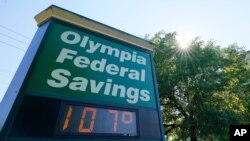The U.S. Pacific Northwest baked under record-breaking temperatures again Monday as the region endures a dangerous heat wave that has placed at least portions of six states under excessive heat warnings from the National Weather Service.
Portland, Oregon, hit 46 Celsius (115 Fahrenheit), an all-time high, by late afternoon. Seattle, Washington, a city known for its normally cool and rainy climate, also broke records: 41.6 C (107 F) at the National Weather Service Seattle station and 41 C (106 F) at Seattle-Tacoma International Airport.
Temperatures are expected to fall starting Tuesday with highs in the low 90s.
The two cities broke all-time heat records over the weekend, as Portland reached 44 C (111 F) on Sunday, setting a new record from the day before when the mercury climbed to 42 C (108 F).
Seattle’s temperature rose to a record of 40 C (104 F) on Sunday.
Portland and Seattle rank among the three least air-conditioned cities in the nation, according to a study by The Seattle Times, compounding the impacts of the heat wave for residents.
Numerous other records broke on Sunday in Washington, Oregon and California, including the record for the highest temperature ever recorded during the month of June in Washington state.
According to heat alerts published by the National Weather Service, the extreme temperatures “significantly increase the potential for heat-related illnesses,” such as heat stroke and in some cases, death.
A man visiting California died last week after spending an hour in the sun, during which he reached an internal body temperature of nearly 41 C (105.8).
Heat kills more Americans in an average year than any other weather event, though it rarely receives the same amount of attention as more visibly destructive natural disasters such as hurricanes or tornadoes.
Though heat-related deaths are rare, the soaring temperatures pose health risks, prompting cities like Portland and Seattle to open public cooling centers, where they offer food, water and air conditioning.
Officials even delayed the Olympic trials in Eugene, Oregon, for several hours Sunday, citing health concerns for the athletes and spectators.
The excessive heat levels are a result of a “heat dome,” which happens when high atmospheric pressures interact with cold winds coming from the Pacific Ocean and create a “dome,” which traps heat under it.
According to The Washington Post, this specific heat dome is so strong that it statistically occurs only once every several thousand years.






